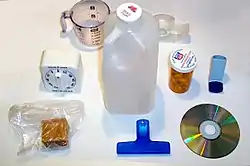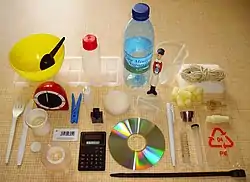.jpg.webp)
Solid polymeric foam for packaging under the optical microscope.
A polymeric foam is a special foam, in liquid or solidified form, formed from polymers.[1]
Examples include:
- Ethylene-vinyl acetate (EVA) foam, the copolymers of ethylene and vinyl acetate; also referred to as polyethylene-vinyl acetate (PEVA)
- Low-density polyethylene (LDPE) foam, first grade of polyethylene (PE)
- Nitrile rubber (NBR) foam, the copolymers of acrylonitrile (ACN) and butadiene
- Polychloroprene foam or Neoprene
- Polyimide foam
- Polypropylene (PP) foam, including expanded polypropylene (EPP) and polypropylene paper (PPP)
- Polystyrene (PS) foam, including expanded polystyrene (EPS), extruded polystyrene foam (XPS) and sometimes polystyrene paper (PSP)
- Styrofoam, including extruded polystyrene foam (XPS) and sometimes expanded polystyrene (EPS)
- Polyurethane (PU) foam
- LRPu low-resilience polyurethane
- Memory foam
- Sorbothane
- Polyurea foam
- Polyethylene foam, as used in PEF rod
- Polyvinyl chloride (PVC) foam
- Silicone foam
- Microcellular foam
See also
References
- ↑ Taskin, Omer Suat (2023). "Polymeric Foams: Materials, Technology, and Applications". American Chemical Society. 1440: 51–63 – via ACS Publications.
This article is issued from Wikipedia. The text is licensed under Creative Commons - Attribution - Sharealike. Additional terms may apply for the media files.

